Thalictrums , or meadow rues, are mainly herbaceous perennials, often with delicate, fern-like foliage, and small flowers in shades of purple, mauve, white or acid-green. They take their name from Thalia, one of the Greek muses, and often exude a delicate, willowy charm that few of us can resist. They have much to offer as garden plants, with many having the rare qualities of a delicate, understated elegance, attractive foliage as well as flowers, and a strong architectural presence.
You may also like
- 26 summer flowers to plant
- Perfect early summer flowers for the garden
- Plants that will make your garden look good all year round
What are thalictrum?
Members of the Ranunculaceae or buttercup family, there are some 150 species of thalictrums, although relatively few of these are grown in cultivation.
Many of those that make successful garden plants originate in the temperate climate of the northern hemisphere and are completely hardy. More tender thalictrums can be found in the tropical parts of the Americas and South Africa. Several interesting species come from the Himalayas, eastwards to China, Korea and Japan, where they grow along the banks of streams, damp meadows and shady conditions.
Like many in the buttercup family, or Ranunculaceae, thalictrum contain toxic alkaloids, so they are rabbit- and deer-proof. The young foliage is also ignored by slugs.
Contact with the foliage may irritate the skin so it’s advisable to wear gloves when handling thalictrums.
Jump to
- How to grow thalictrum from seed
- When does thalictrum flower?
- Where to grow thalictrum
- How to divide thalictrum
- How to care for thalictrum
- What to plant with thalictrum
- The best thalictrum to grow
- Where to see and buy thalictrum

How to grow thalictrum
How to grow thalictrum from seed
The longest-flowering thalictrums are sterile, setting no seeds, and therefore have to be raised by micro propagation. However, thalictrums with stamens do set seeds and will hybridise. If you have a good form, I’d advise deadheading then raising any progeny by taking root cuttings.
Thalictrums are easy to grow from seed, but this must be sown once it ripens on the plants in late summer or autumn. Thalictrum seed (as with many members of the buttercup family) has a short period of viability.
When does thalictrum flower?
Most thalictrums flower through summer, from July through to September.
Where to grow thalictrum
Many thalictrums originate from damp, often shaded situations, so tend to prefer those type of conditions, however, most will do well in moist, well-drained, humus-rich soil in a sheltered position, with or without shade, as long as their roots are not allowed to dry out.
Thalictrums generally hate dry summers and drought, so be prepared to water them in droughts especially in their first season. It’s advisable to mulch well to help conserve moisture.

How to divide thalictrum
To propagate named cultivars, divide the rootstock of established clumps in early spring, just before they come into growth. Pot up the divisions and grow on until roots are well established, before planting out in the garden.
How to care for thalictrum
Taller thalictrum often need some support, but it’s best done discreetly with pea sticks or thin metal stakes. Growing them in the middle of a border gives them some support from surrounding plants and also helps hide any shabby foliage low down.
Remember to deadhead if you don’t want plants to self seed.
Mulch thalictrums in spring, to help conserve moisture in the soil.
When to cut back thalictrum
Cut down the stems to the ground after flowering.
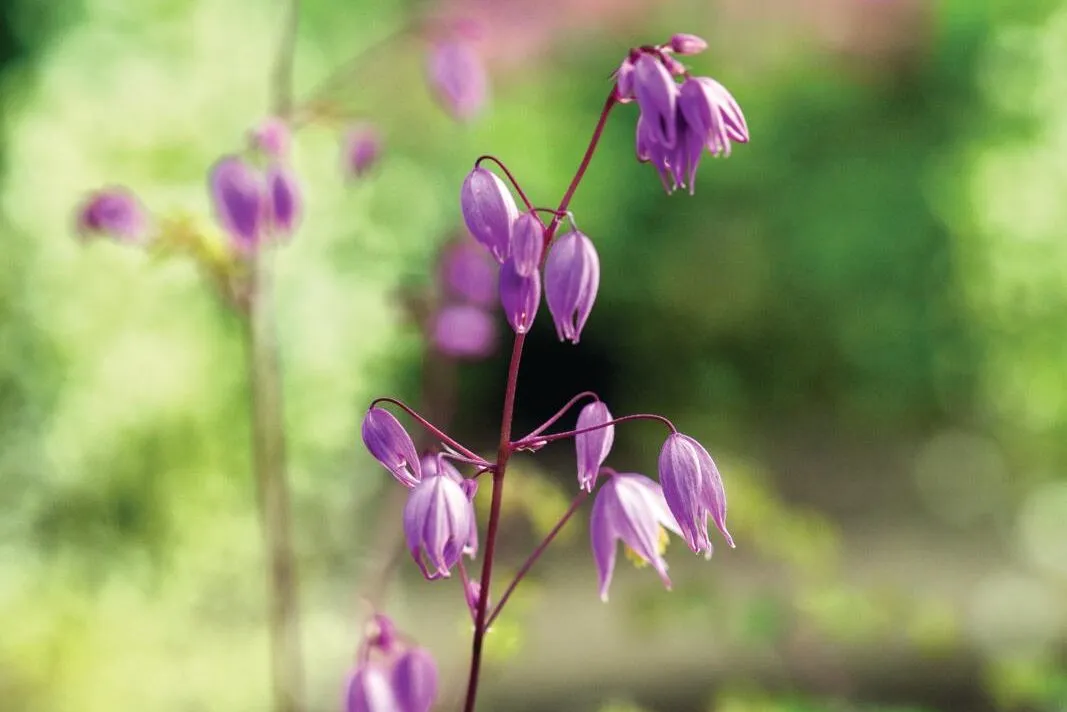
What to plant with thalictrum
Thalictrums with colourful stems are extremely useful in modern prairie-planting schemes that involve statuesque, late-flowering perennials and grasses. This is because thalictrums are out of the ground by March and by mid-April they're 30cm high while the rest of the border is generally still underground. The new growth emerges like strong asparagus spears, then leafs into purple-flushed growth. This doesn't get eaten by slugs, or suffer from frost damage, so is often used as a backbone in continental planting.
April-flowering tulips work well with young thalictrum foliage and you can create a beautiful blend with the dusky Triumph tulips 'Shirley' and 'Negrita', or set off an ivory-cream Darwin tulip, such as 'Floradale'.
The best thalictrum to grow
Thalictrum delavayi ‘Ankum’

Come July, this very select, airy form produces generous sprays of pale-lilac ‘petals’ surrounding sulphur-yellow stamens. A selection made by Coen Jansen and named for his nursery in Ankummer, in the Netherlands.
Height 2m. Hardiness rating USDA 5a.
Thalictrum delavayi var. decorum

Long, dark, wiry stems hold small, delicate, three-lobed, green leaves topped by relatively large, bluish-purple flowers, each with four pointed ‘petals’ set around a boss of golden stamens.
Height 1m. Hardiness rating USDA 5b-8b.
Thalictrum lucidum

Slender and upright with stiff, ridged, green stems and unusual shiny, green, herringbone-shaped foliage. The fragrant, wispy, lemon flowers appear in July, by which time the leaves will have yellowed.
Height 2-3m. Hardiness rating USDA 7a-9b.
Thalictrum Splendide White (= ‘Fr21034’)
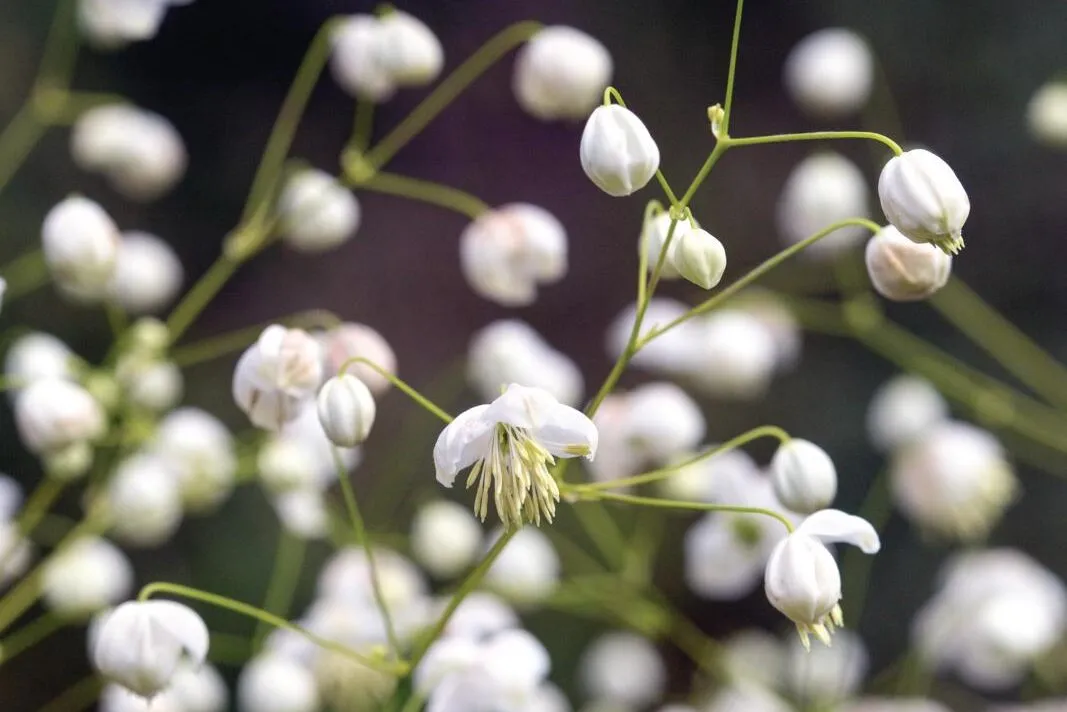
Selected by French breeder Thierry Delabroye from a cross between Thalictrum delavayi and Thalictrum elegans, this produces a profusion of sparkling white flowers on elegant stems above aquilegia-like foliage.
Height 2m. Hardiness rating USDA 4a-7b.
Thalictrum delavayi var. mucronatum

Very similar to Thalictrum delavayi var. decorum, but is often taller and perhaps with a definite point to the end of each petal. The pretty, bell-shaped flowers are lilac-pink with primrose stamens. Stood out on the trial.
Height 2m.
Thalictrum ramosum
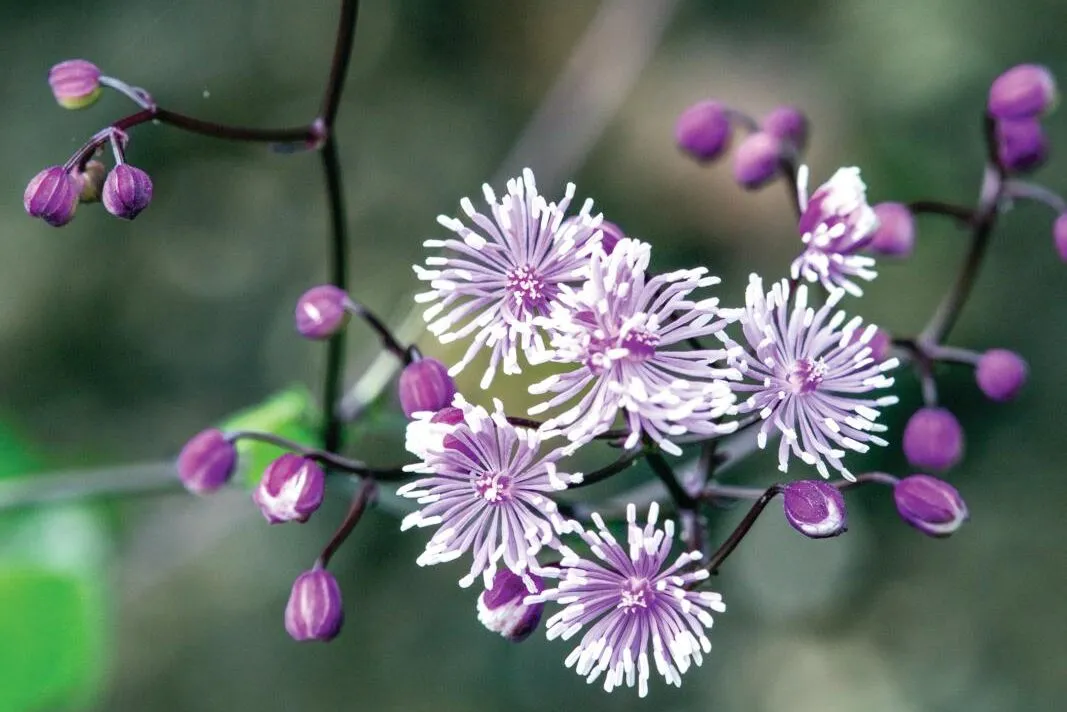
A dainty Chinese thalictrum with black, wiry stems and dark buds held above tiny, blue-green leaves. Flowers are large, lavender orbs of stamens and last a very long time. Only available at Crûg Farm Plants.
Height 30-40cm.
Thalictrum flavum subsp. glaucum
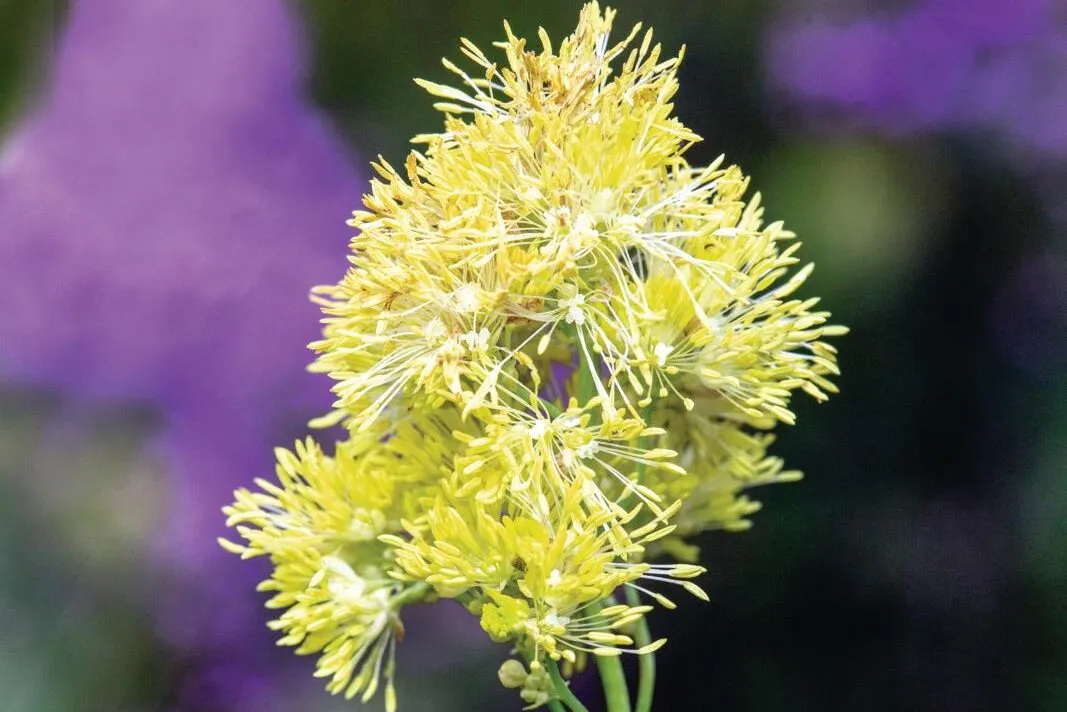
Grown for its handsome powdery, blue-grey foliage, strong upright stems and frothy, yellow flowers. Foliage emerges pale-yellow and is often used with dark tulips. Height 1.5m. Hardiness rating RHS H7, USDA 5a-9b.
Thalictrum ichangense
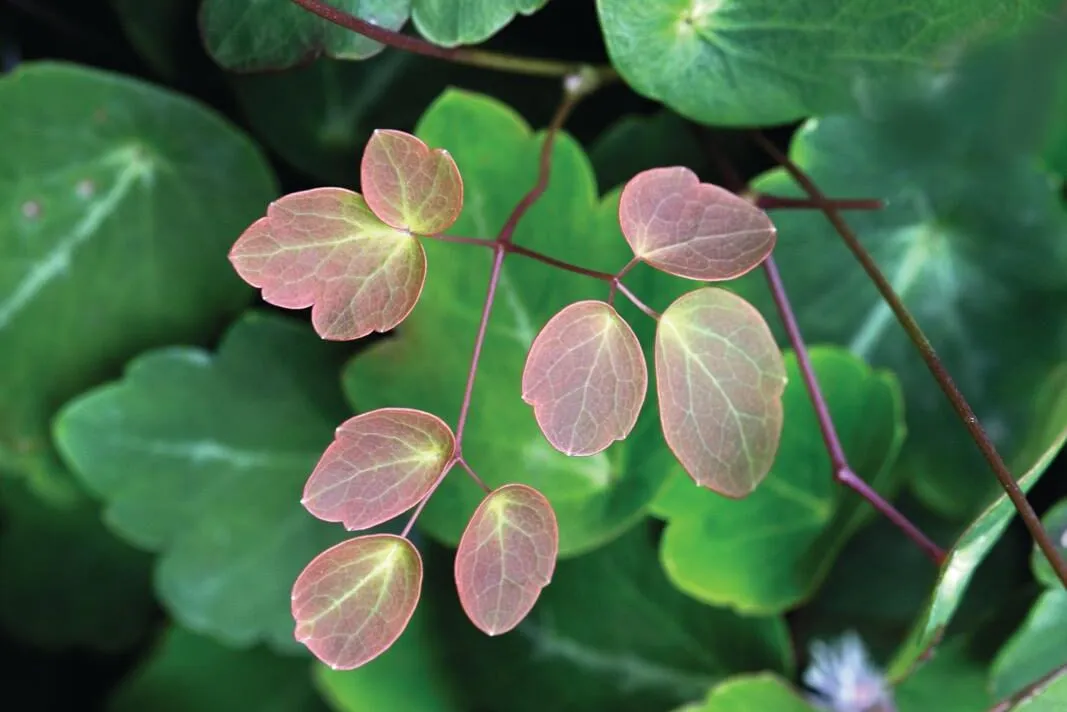
A small, slow-growing Asian species with huge potential if it proves reliable over winter. The plum-leaved forms have miniature begonia-like foliage. Several duskier forms are being micropropagated.
Height 5cm. Hardiness rating USDA 6a-9b.
Thalictrum ‘Anne’

A star performer with dramatic, architectural stems that are thinner and blacker than those of ‘Elin’ but still self-supporting. Pretty, blue-green foliage and pink buds that mature to white, but ordinary flowers.
Height 2.5m.
Thalictrum ‘Elin’
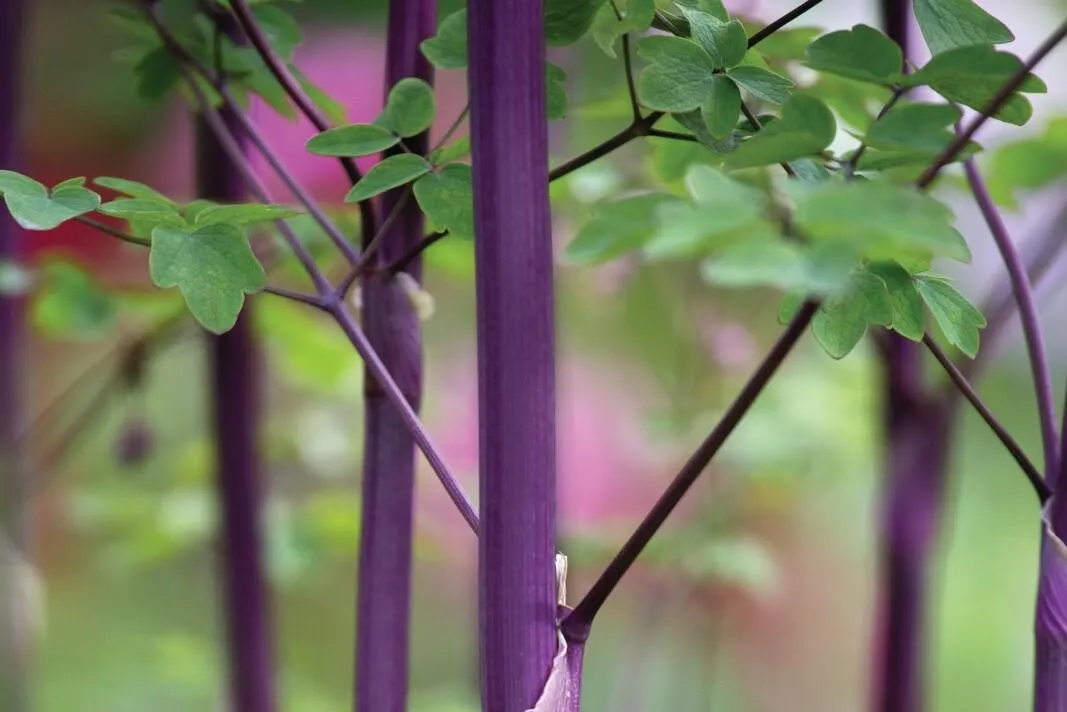
Tall, strong, damson-toned stems, purple-flushed grey-blue foliage and delicate purple and cream flowers. At Great Dixter in East Sussex it’s used with the purple Tulipa ‘Shirley’ to great effect.
Height 2.5m. Hardiness rating USDA 5a-9b.
Thalictrum minus ‘Adiantifolium’
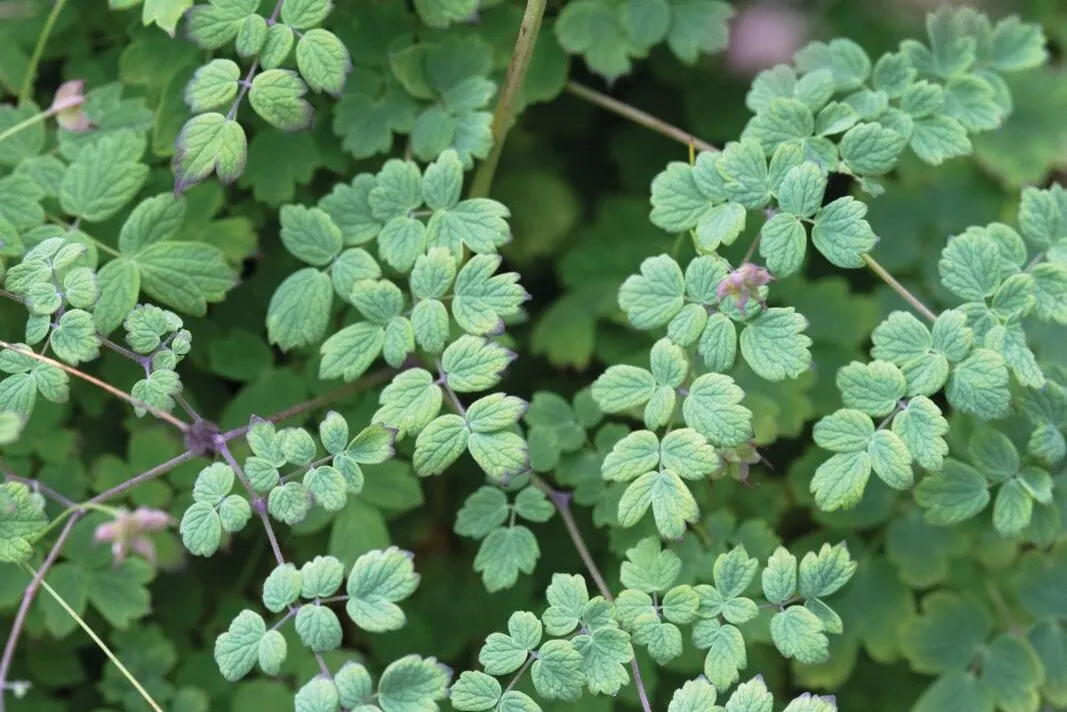
Small and low growing with delicate foliage, similar to a maidenhair fern, which lasts well all season. A perfect foliage plant for quiet, shady areas. Clump forming and non-invasive. Insignificant yellowish flowers.
Height 30-40cm.
Thalictrum ‘Tukker Princess’
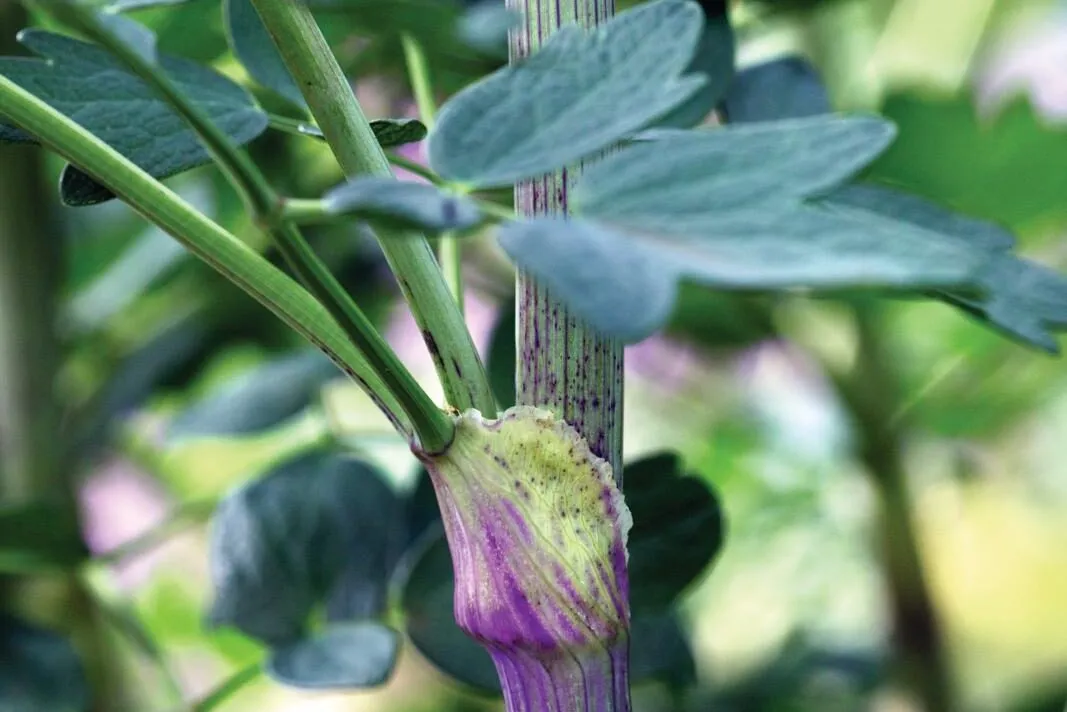
A giant form with stems striped in pink, dusky-grey and lime-green – reminiscent of a pair of grandad’s well-washed pyjamas. Large soft-yellow flowers contrast with the glaucous, ferny foliage that lasts until November. Spectacular.
Height 2-3m.
Thalictrum 'Black Stockings'

Thalictrum 'Black Stockings' is a recent introduction that has swiftly become a favourite. As its name suggests, it has dark black stems, which contrast beautifully with the lavender-purple flowers and delicate, scallloped foliage.
Height 2m.
Where to see and buy thalictrum
Aberglasney Gardens
Llangathen
Camarthenshire
SA32 8QH
Tel 01558 668998
Great Dixter
Northiam
Rye
East Sussex
TN31 6PH
Tel 01797 252878
For more information on hardiness ratings, click here.




